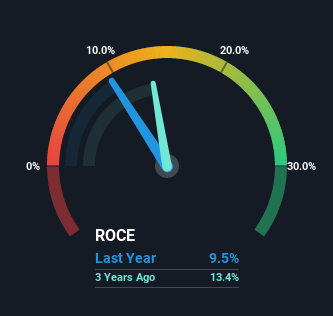- United States
- /
- Electronic Equipment and Components
- /
- NasdaqGS:NATI
Here's What To Make Of National Instruments' (NASDAQ:NATI) Decelerating Rates Of Return

There are a few key trends to look for if we want to identify the next multi-bagger. Ideally, a business will show two trends; firstly a growing return on capital employed (ROCE) and secondly, an increasing amount of capital employed. Ultimately, this demonstrates that it's a business that is reinvesting profits at increasing rates of return. Having said that, from a first glance at National Instruments (NASDAQ:NATI) we aren't jumping out of our chairs at how returns are trending, but let's have a deeper look.
Understanding Return On Capital Employed (ROCE)
For those that aren't sure what ROCE is, it measures the amount of pre-tax profits a company can generate from the capital employed in its business. The formula for this calculation on National Instruments is:
Return on Capital Employed = Earnings Before Interest and Tax (EBIT) ÷ (Total Assets - Current Liabilities)
0.095 = US$160m ÷ (US$2.1b - US$390m) (Based on the trailing twelve months to March 2022).
So, National Instruments has an ROCE of 9.5%. On its own, that's a low figure but it's around the 11% average generated by the Electronic industry.
View our latest analysis for National Instruments

Above you can see how the current ROCE for National Instruments compares to its prior returns on capital, but there's only so much you can tell from the past. If you're interested, you can view the analysts predictions in our free report on analyst forecasts for the company.
What The Trend Of ROCE Can Tell Us
The returns on capital haven't changed much for National Instruments in recent years. Over the past five years, ROCE has remained relatively flat at around 9.5% and the business has deployed 37% more capital into its operations. Given the company has increased the amount of capital employed, it appears the investments that have been made simply don't provide a high return on capital.
Our Take On National Instruments' ROCE
Long story short, while National Instruments has been reinvesting its capital, the returns that it's generating haven't increased. Since the stock has declined 17% over the last five years, investors may not be too optimistic on this trend improving either. Therefore based on the analysis done in this article, we don't think National Instruments has the makings of a multi-bagger.
National Instruments does come with some risks though, we found 2 warning signs in our investment analysis, and 1 of those is a bit unpleasant...
If you want to search for solid companies with great earnings, check out this free list of companies with good balance sheets and impressive returns on equity.
Valuation is complex, but we're here to simplify it.
Discover if National Instruments might be undervalued or overvalued with our detailed analysis, featuring fair value estimates, potential risks, dividends, insider trades, and its financial condition.
Access Free AnalysisHave feedback on this article? Concerned about the content? Get in touch with us directly. Alternatively, email editorial-team (at) simplywallst.com.
This article by Simply Wall St is general in nature. We provide commentary based on historical data and analyst forecasts only using an unbiased methodology and our articles are not intended to be financial advice. It does not constitute a recommendation to buy or sell any stock, and does not take account of your objectives, or your financial situation. We aim to bring you long-term focused analysis driven by fundamental data. Note that our analysis may not factor in the latest price-sensitive company announcements or qualitative material. Simply Wall St has no position in any stocks mentioned.
About NasdaqGS:NATI
National Instruments
National Instruments Corporation provides a software-centric platform to engineers and scientists worldwide.
Excellent balance sheet with proven track record and pays a dividend.


